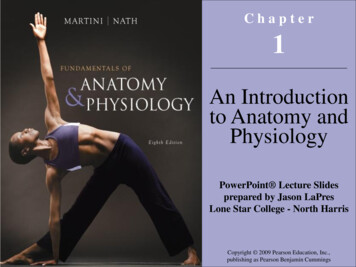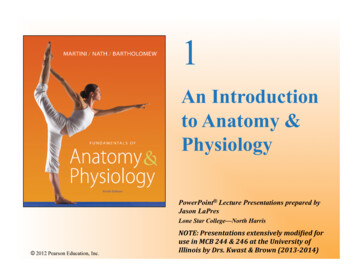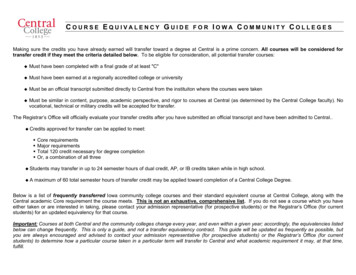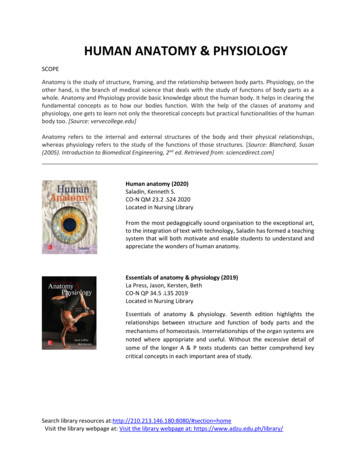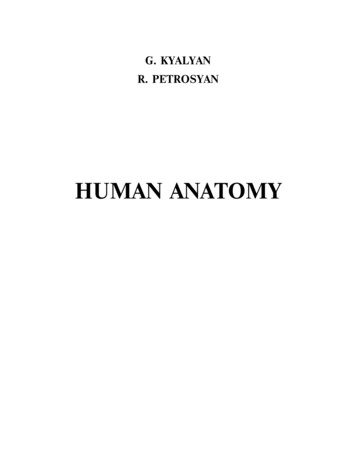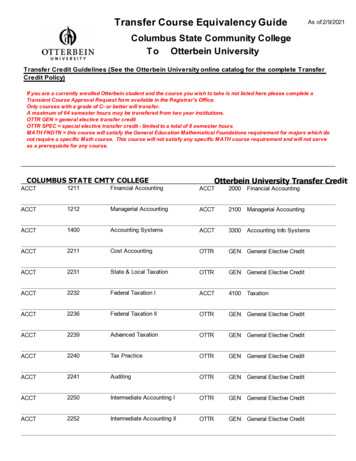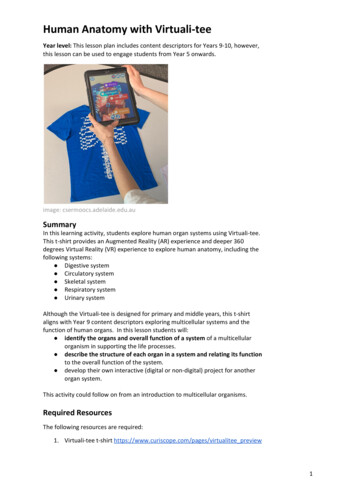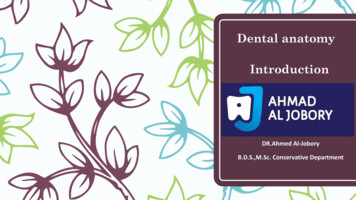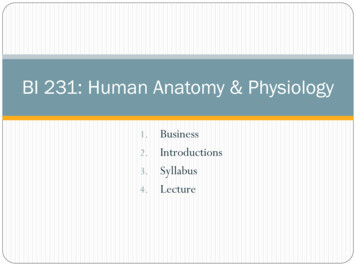
Transcription
BI 231: Human Anatomy & PhysiologyBusiness2. Introductions3. Syllabus4. Lecture1.
Homework Due in lab this weekHomework #1 – What Does the Syllabus Say?2. Basic Principles 9 & 10 – Anatomical Terms & Body Cavities1. Due Monday 10/1/12, beginning of class1.Study Guide Introduction Section, Read pages 5 & 6 Complete Page 7 to turn in (also found as HW #2-Studying for Success)2.Homework #3 (pages 5, 6 & 7) – Composition of Matter
Introduction toAnatomy and Physiology
Anatomy and Physiology Two complementary branches of science Anatomy Structure of body parts and their relationships to one another Physiology Function of the body Events at the cellular or molecular level
Basic Concepts1. Structural-functional relationships2. Emergent properties3. Homeostasis
Basic Concepts Relationship between structure and function Structure (anatomy) of a component is defined by its function(physiology) Function always reflects structure Principle of complementarity
Examples1. Bone2. Skin3. Blood vessels
Examples1. Bonea)b)What is it’s function?How does the structureof bone serve it’s function?
BonesJointSkeletal SystemProtects and supports body organs,and provides a framework the musclesuse to cause movement.Copyright 2010 Pearson Education, Inc.Figure 1.3b
Examples2. Skina)b)What is/are it’s function(s)?How does the structure of skin serve it’s function(s)?
SkinIntegumentary SystemForms the external body covering, andprotects deeper tissues from injury.Copyright 2010 Pearson Education, Inc.Figure 1.3a
Examples3. Blood vesselsa)b)What are their function(s)?How does the structure of a blood vessel serve it’s function(s)?
HeartBloodvesselsCardiovascular SystemBlood vessels transport blood,which carries oxygen, carbondioxide, nutrients, wastes, etc.Copyright 2010 Pearson Education, Inc.Figure 1.3f
Emergent Properties Characteristics that develop or emerge as a result of theorganization within the system Living organisms are more than a sum of their parts!
Hierarchical Levels of nOrgan SystemOrganism
AtomsMolecule1 Chemical levelAtoms combine to form molecules.Copyright 2010 Pearson Education, Inc.Figure 1.1, step 1
AtomsMolecule1 Chemical levelAtoms combine to form molecules.Copyright 2010 Pearson Education, Inc.OrganelleSmooth muscle cell2 Cellular levelCells are made up ofmolecules.Figure 1.1, step 2
AtomsMolecule1 Chemical levelAtoms combine to form molecules.OrganelleSmooth muscle cell2 Cellular levelCells are made up ofmolecules.Smooth muscle tissue3 Tissue levelTissues consist of similartypes of cells.Copyright 2010 Pearson Education, Inc.Figure 1.1, step 3
AtomsMolecule1 Chemical levelAtoms combine to form molecules.OrganelleSmooth muscle cell2 Cellular levelCells are made up ofmolecules.Smooth muscle tissue3 Tissue levelTissues consist of similartypes of cells.Blood vessel (organ)Smooth muscle tissueConnective tissueEpithelialtissue4 Organ levelOrgans are made up of different typesof tissues.Copyright 2010 Pearson Education, Inc.Figure 1.1, step 4
AtomsOrganelleSmooth muscle cellMolecule1 Chemical levelAtoms combine to form molecules.CardiovascularsystemHeartBloodvessels2 Cellular levelCells are made up ofmolecules.Smooth muscle tissue3 Tissue levelTissues consist of similartypes of cells.Blood vessel (organ)Smooth muscle tissueConnective tissueEpithelialtissue4 Organ levelOrgans are made up of different typesof tissues.5 Organ system levelOrgan systems consist of differentorgans that work together closely.Copyright 2010 Pearson Education, Inc.Figure 1.1, step 5
AtomsOrganelleSmooth muscle cellMolecule1 Chemical levelAtoms combine to form molecules.CardiovascularsystemHeartBloodvessels2 Cellular levelCells are made up ofmolecules.Smooth muscle tissue3 Tissue levelTissues consist of similartypes of cells.Blood vessel (organ)Smooth muscle tissueConnective tissueEpithelialtissue4 Organ levelOrgans are made up of different typesof tissues.6 Organismal levelThe human organism is made upof many organ systems.Copyright 2010 Pearson Education, Inc.5 Organ system levelOrgan systems consist of differentorgans that work together closely.Figure 1.1, step 6
Homeostasis Ability to maintain an internal environment withindefined parameters Example: interstitial fluid Exchange between external and internal environment Stress Dynamic equilibrium
Digestive systemTakes in nutrients, breaks themdown, and eliminates unabsorbedmatter (feces)Respiratory systemTakes in oxygen andeliminates carbon dioxideFoodAll of theseorgan systemsinteract andcontribute tomaintenanceof homeostasisO2CO2Cardiovascular systemBloodCO2O2HeartNutrientsInterstitial fluidUrinarysystemNutrients and wastes passbetween blood and cellsvia the interstitial fluidIntegumentary systemFeces Protects the body as a whole Urinefrom the external environmentFigure 1.2
Homeostatic Mechanisms Restore balance of set parameters Example Exercise decreases normal oxygen concentration in blood. Howdoes the body compensate?
Homeostatic Feedback Sensor (receptor) Controller Effector
01 02A negative feedbackmechanism
01 03
1Stimulusproduceschange invariable.BALANCEFigure 1.4, step 1
ange invariable.BALANCEFigure 1.4, step 2
3 Input: Informationsent along afferentpathway to olCenterAfferentpathway1Stimulusproduceschange invariable.BALANCEFigure 1.4, step 3
3 Input: Informationsent along afferentpathway to controlcenter.2Receptordetectschange.Receptor4 Information sent alongefferent pathway toeffector.Effector1Stimulusproduceschange invariable.BALANCEFigure 1.4, step 4
3 Input: Informationsent along afferentpathway to controlcenter.2Receptordetectschange.Receptor4 1Stimulusproduceschange invariable.BALANCEInformation sent alongefferent pathway toeffector.Effector5Responseof effectorfeeds backto reducethe effect ofstimulusand returnsvariable tohomeostaticlevel.Figure 1.4, step 5
Positive Feedback
Types of Feedback MechanismsPositive FeedbackNegative Feedback Relatively rare, usually Most mechanisms are of this Result or response Cause variable to change incontrol infrequent eventsenhances original stimulus Ex: Childbirth or bloodclottingtypedirection opposite to that ofthe initial change Ex: Maintenance of bloodpressure or body temperature
Chemical level Atoms combine to form molecules. Cellular level Cells are made up of molecules. Tissue level Tissues consist of similar types of cells. Organ level Organs are made up of different types of tissues. Organ system level6 Organ systems consist of different organs that work together closely. Organismal level The human organism is made up
